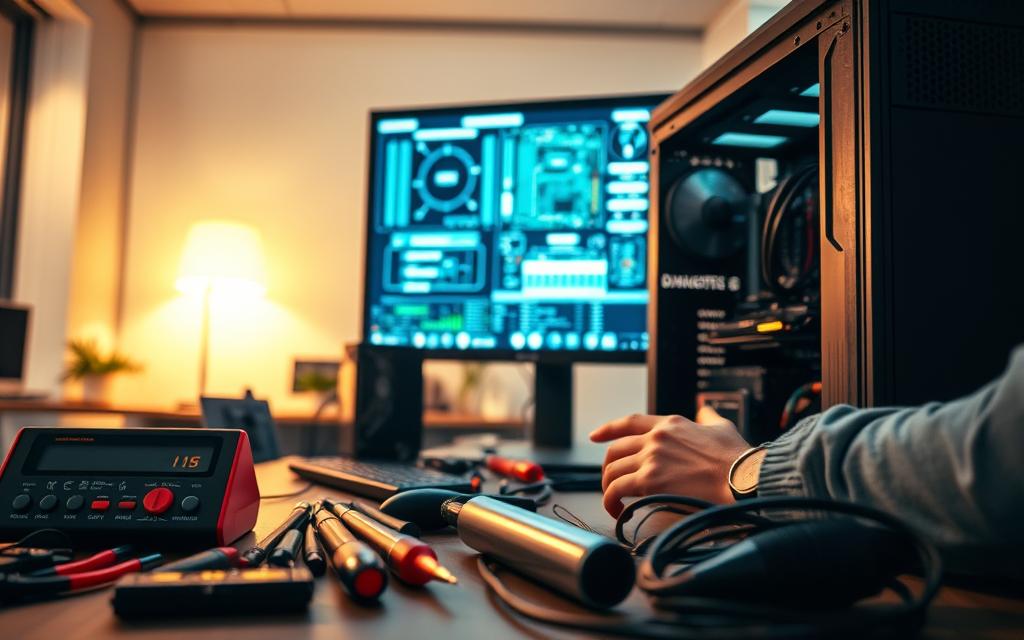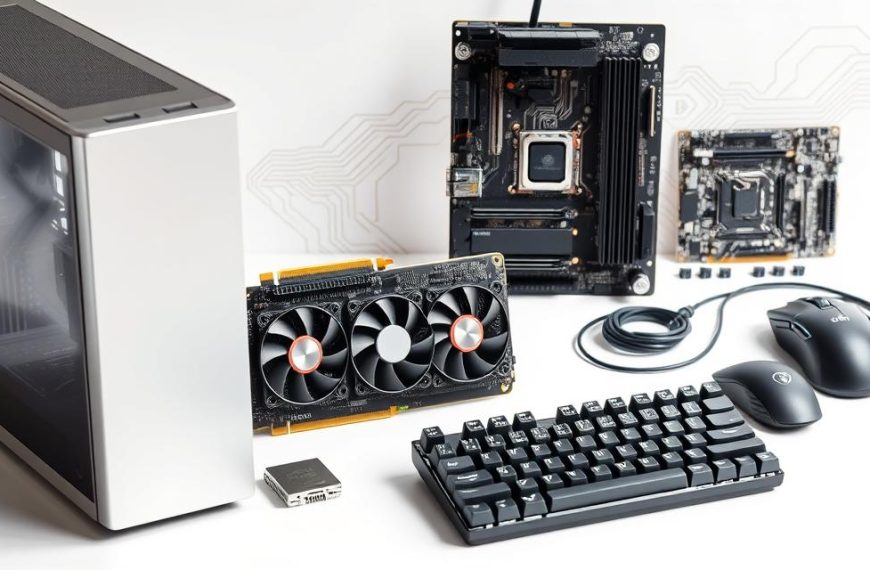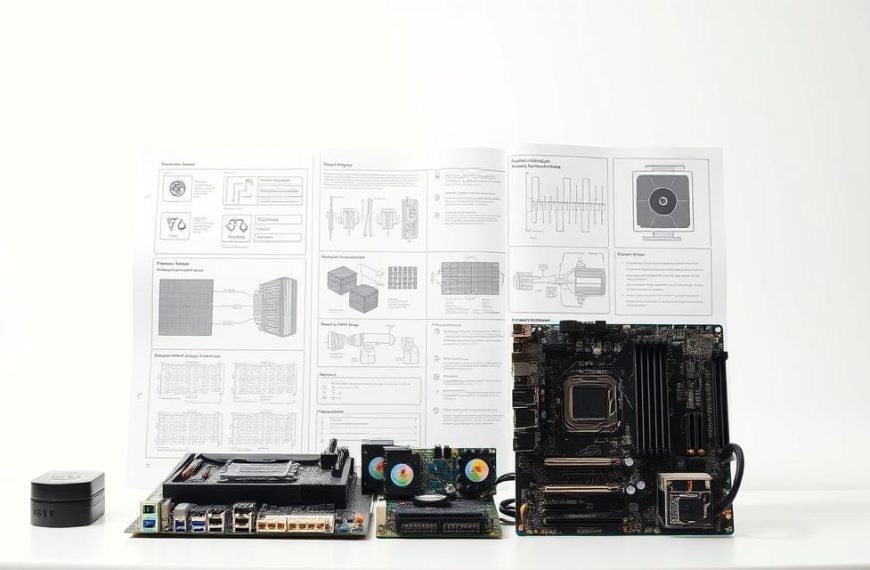Keeping your computer’s hardware in top shape is vital for smooth operation. Regular checks can stop sudden breakdowns and safeguard your data. Many users don’t realise they can spot hardware issues early through active monitoring.
Knowing your PC’s key parts helps you catch problems before they grow. These include hard disks, CPU, GPU, motherboard, RAM, and battery. Regular upkeep can prevent most hardware troubles, much like servicing your car.
Slow performance is a common sign of hardware issues. It often comes from RAM, CPU, or storage failures. Other red flags include system crashes, odd noises, and unexpected overheating.
This guide will show you how to check your computer’s hardware health. We’ll look at built-in Windows tools and other software options. Our aim is to help you keep your system running well and avoid data loss.
Understanding Common Hardware Issues and Warning Signs
Computer hardware can develop critical issues that affect system performance and reliability. Spotting early warning signs helps prevent data loss and system failures. Users can take proactive steps to maintain their computer’s health by understanding hardware problem symptoms.
Hardware diagnostics show that 20% of system issues come from memory-related problems. RAM failure symptoms are crucial to identify. Users should watch for unexpected system behaviours that might signal hardware challenges.
Signs of RAM Failure
RAM failure can show through several distinctive symptoms:
- Frequent system crashes and unexpected blue screens
- Random application freezes
- Corrupted files and data
- Persistent error messages during startup
Storage Drive Warning Signals
Hard drive health is vital for data preservation. About 60% of organisations lose data due to drive issues. Look out for these warning signs:
- Unusual clicking or grinding noises
- Slow file access and transfer speeds
- Frequent disk read/write errors
- Unexplained file corruption
GPU Performance Red Flags
Graphics card problems can severely impact system performance. GPU issues often appear as visual anomalies and performance drops:
- Screen flickering or artifacting
- Graphics rendering problems
- System lockups during graphically intensive tasks
- Unexpected display driver crashes
Early detection of hardware issues can prevent catastrophic system failures and data loss.
Regular system checks can cut hardware failure risk by up to 40%. Staying alert and addressing warning signs quickly can extend your computer’s life. This approach helps maintain optimal performance over time.
Built-in Windows Diagnostic Tools
Windows offers powerful tools for thorough system health checks. These diagnostics provide insights into your computer’s hardware performance and potential issues. Using these tools helps maintain your system’s reliability and efficiency.
Performance Monitor: System Performance Tracking
Performance Monitor is a robust tool for detailed system health assessment. It tracks critical performance metrics across multiple system components.
- Real-time monitoring of processor usage
- Memory utilisation tracking
- Detailed performance counter analysis
- Customisable reporting options
Windows Memory Diagnostic Tool: RAM Health Verification
The Windows Memory Diagnostic tool checks RAM integrity. You can access it by searching in the taskbar.
Choose between two diagnostic modes:
- Restart now and check for problems
- Check for problems during next computer startup
After running the diagnostic, review results in the Event Viewer. This helps identify potential memory-related issues.
DirectX Diagnostic Tool: Graphics and Sound Assessment
DirectX Diagnostic Tool (DxDiag) evaluates graphics and sound card performance. It provides information about multimedia components. This helps diagnose potential hardware conflicts or performance limitations.
Pro tip: Regularly using these Windows diagnostic tools can prevent system failures. It also maintains optimal computer performance.
How to Check the Hardware of a Computer Using Third-Party Software
Third-party system health tools offer deep insights into your PC’s performance. These tools go beyond built-in Windows utilities, giving you more information about your computer’s health.
Several powerful PC benchmarking tools excel at hardware diagnostics. These tools can help you spot issues before they become serious problems.
- MemTest86+: A robust tool for thorough RAM testing
- CrystalDiskInfo: Provides extensive storage drive health information
- HWiNFO: Offers system-wide hardware monitoring capabilities
Professional hardware diagnostic software can detect potential issues early on. This helps users keep their computers running smoothly and avoid unexpected breakdowns.
Understanding your computer’s hardware health is crucial for preventing unexpected system failures and maintaining peak performance.
When choosing hardware diagnostic software, look for these key features:
- Comprehensive component scanning
- Real-time performance monitoring
- Detailed reporting capabilities
- User-friendly interface
Advanced tools like Speccy and HWiNFO offer quick views of your computer’s internals. These tools make complex diagnostics easy for users of all skill levels.
Monitoring Storage Drive Health and Performance
Safeguarding your digital data starts with knowing your storage drives’ health. Drive health monitoring prevents unexpected data loss and keeps systems reliable. Modern computing uses proactive drive diagnostics to foresee potential hardware failures.
S.M.A.R.T. offers a key framework for tracking storage device performance. This advanced technology gives deep insights into drive conditions. It helps users spot potential issues before they worsen.
Understanding S.M.A.R.T. Reports
S.M.A.R.T. data captures vital metrics about your storage drive’s health. These include:
- Read/write error rates
- Temperature fluctuations
- Spin-up time
- Reallocated sector count
Utilising CrystalDiskInfo for Diagnostics
CrystalDiskInfo is a powerful tool for thorough drive health monitoring. It interprets S.M.A.R.T. data, giving users clear status indicators about their storage devices’ condition.
Effective Data Backup Strategies
When drive health indicators show potential issues, strong data backup strategies are crucial. Recommended approaches include:
- Regular automated backups
- Multiple backup locations
- Cloud storage solutions
- Periodic drive health checks
Proactive monitoring and timely backups can significantly reduce the risk of catastrophic data loss.
Advanced GPU and CPU Health Assessment
GPU diagnostics are vital for system performance. FurMark stress tests graphics cards, revealing potential vulnerabilities. A 15% or more drop in FPS signals significant hardware issues.
Hardware stress testing is crucial for CPU health checks. The Intel Processor Diagnostic Tool offers comprehensive analysis in 5-10 minutes. It has a 10% failure rate under intense workloads.
Overclocking can reduce CPU lifespan by 20-30% if not managed properly. Professional users should be aware of this risk.
AIDA64 Extreme provides real-time tracking of temperatures, voltages, and fan speeds. This helps identify thermal throttling and performance issues early. Users can assess their system’s components proactively.
Regular diagnostic checks can boost component lifespan by up to 25%. Manufacturer-specific tools like AMD Ryzen Master help maintain optimal system health. These tools prevent potential hardware failures before they become critical.









